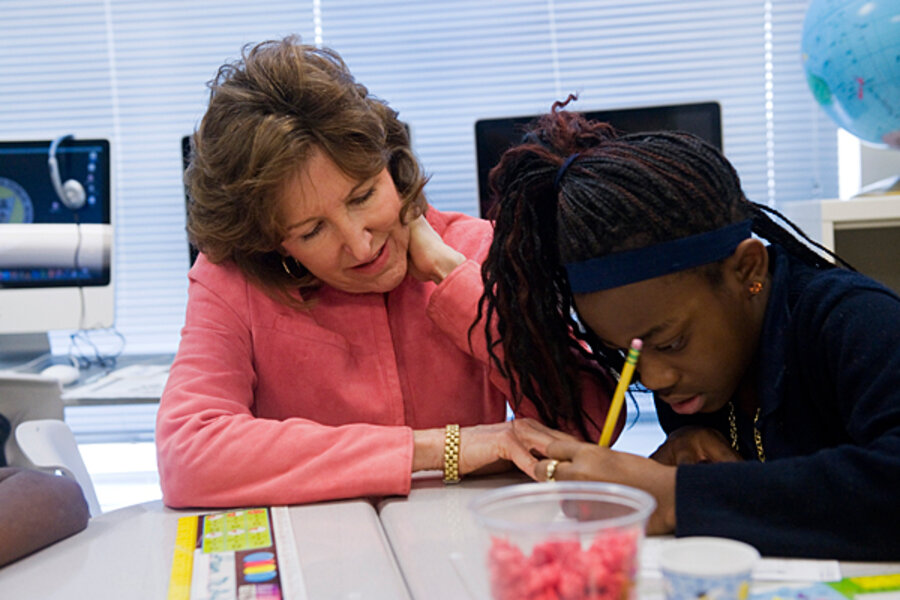Senator Hagan introduces bill to turn around worst schools: Can it work?
Loading...
America’s worst public schools would see an infusion of $600 million in 2012 – with strings attached for dramatic reforms – under a bill introduced Thursday on Capitol Hill.
Sen. Kay Hagan (D) of North Carolina announced the School Turnaround and Rewards (STAR) Act on Thursday morning.
The United States has more than 2,000 “dropout factory” high schools in which fewer than 60 percent of students graduate, as well as 1,800 elementary and middle schools where fewer than 4 in 10 students are proficient in math and reading.
“These persistently low-performing schools are broken [and] need intensive reform,” Senator Hagan said in a conference call with reporters. “Unfortunately, under No Child Left Behind, states and districts frequently shy away from intensive action. They instead choose to implement minor reforms that are not working.”
Hagan is among a group of moderate Democratic senators pushing legislation that supports President Obama’s blueprint for changing No Child Left Behind (NCLB), the current version of the Elementary and Secondary Education Act (ESEA), which is long overdue for a rewrite in Congress.
The STAR Act addresses just one part of the massive federal accountability law. Hagan hopes it will be incorporated into a more comprehensive ESEA reform bill.
It would distribute money to states yearly, and they would distribute it to districts that have competed for grants to turn around schools that rank in the lowest 5 percent statewide. They would be required to implement one of these four strategies:
• The “restart” model would convert a school into a charter school or one run by an autonomous organization.
• The “transformation” model puts a new principal in place who has a track record of improving schools. It also introduces a comprehensive set of other changes so that teaching and curriculum are improved with research-based approaches.
• The “turnaround” model takes a similar approach to transformation, but it also replaces at least 50 percent of the staff.
• The “closure” model shuts down the school and disperses students to other schools in the district.
The bill, cosponsored by Sen. Joseph Lieberman (I) of Connecticut, would also provide an additional $300 million for states to reward schools showing significant progress in improving student performance overall and closing achievement gaps for at least one subgroup of students (such as African-Americans, Hispanics, low-income students, or children with disabilities).
The bill addresses “two critical elements that were missing in NCLB,” said Carmel Martin, an assistant secretary at the US Department of Education, at a panel discussion Thursday morning at the Center for American Progress (CAP) in Washington. “[It has] more focus on the lowest-performing schools ... but also this concept of rewarding success,” she said, so that schools have an incentive to show progress rather than simply meeting the “proficiency” benchmark.
The Obama administration has already invested about $4.5 billion (most of it stimulus money) to try to turn around the worst schools. And it has been requiring the four transformation models when it distributes School Improvement Grants.
The administration’s approach draws on research and experience in the education field, but only time will tell how effective it can be.
Some observers say the approach needs more fine-tuning and more attention to school-district capacity and support. “Simply training better individuals and sticking them into old structures isn’t going to work,” said William Guenther, president of Mass Insight Education, during the CAP event, which was broadcast online.
Another critique “is that the [models] are still narrowly constructed,” says Michael Petrilli, executive vice president at the Thomas B. Fordham Institute in Washington. If a school is in the process of making improvements that haven’t shown up in test scores, he adds, states or districts might need “discretion to say the medicine needed for this school will be different.”
Because some of the models involve large-scale firing of teachers, the turnaround models aren’t very popular with unions. The introduction of this bill is a way for moderate Democrats “to say to the left wing, we’re not going to back down on expecting serious changes in these schools,” Mr. Petrilli says.
Hagan has witnessed some turnaround strategies in her state of North Carolina, which has received $64 million in federal money to transform 25 schools. One of them is Oak Hill Elementary school in High Point. Part of its change was to add 10 days of instruction, plus 45 extra minutes per day during the whole school year. It made double-digit gains in reading during the 2009-10 school year, Hagan said.
School turnaround work is hard, especially in rural districts where it may be difficult to recruit new principals and teachers. The STAR Act includes provisions for supporting the replication of best practices.
Under Mr. Obama’s blueprint for ESEA, this focus on the worst schools would largely replace the current system that requires intervention in all schools that fail to meet “adequate yearly progress” goals for all subgroups of students. However, it would still require schools to report detailed achievement data broken out by subgroup. And some provisions in the law would address achievement gaps at schools more broadly than just the lowest 5 percent.
Some Washington insiders have expressed doubts about the likelihood of an ESEA bill moving forward this year, but Hagan echoed an urgent plea to get it done this year that has been made repeatedly by Obama and US Education Secretary Arne Duncan.
“We cannot wait another year,” Hagan said. “A year in the life of a child cannot be replicated.”





